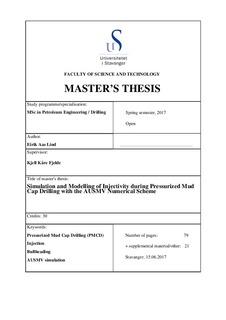| dc.description.abstract | Operation and drilling in highly fractured carbonate formations are associated with several challenges. Some of the main challenges include large/total losses of drilling fluids, loss of hydrostatic pressure and gas influxes. One of the modern drilling technologies that provides a solution, is Pressurized Mud Cap Drilling (PMCD). The main principle of PMCD is to drill with a cheap sacrificial fluid that is forced into the fractured formation along with all cuttings. Nothing is circulated back to surface. The annulus is filled with a fluid designed to cause underbalanced pressure, which encourages influx of gas. When the pressure at the surface rises to a certain level due to gas migration, bullheading is used to force the kick back down into the formation.
To help get a greater understanding of the pressure development before and during PMCD bullheading, computing software is used to model and simulate such complex flow scenarios. In the past, work has been done to implement a PMCD bullheading operation into a numerical scheme, which allowed for simulation and analysis. The model used is a transient model, which uses the numerical procedure of the AUSMV scheme to solve conservation equations from the drift flux model. MatLab computing software is used to perform the calculations, and the model is written in matlab programming language. The goal of this thesis is to continue building on the previous model, and increase the realism of the simulations.
The previous version of the PMCD bullheading code, had shortcomings with regards to injection. Pressure development through time did not account for formation injectivity, and bottomhole injection pressure was fixed to an assumed value. During bullheading, all fluids were assumed to be injected without any resistivity from the formation. Also, during gas migration in the shut-in well, the model did not allow any fluids to flow back into the formation as the pressure increased in the bottom. In this thesis, the Injectivity Index model is implemented into the model to solve these two problems.
The injectivity model was simulated and tested with two different methods of implementation, through the boundary cell fluxes, and through the source term of the partial differential equations. Tests were also done to see effects from different degree of injectivity. Compared to the original pressure plots, the new results showed a much more realistic pressure development, both during bullheading and during gas migration in shut-in well. The results also showed that the pressure development in the well is highly dependent on the injectivity of the formation. For simulation with injection through the bottom cell, the difference between the boundary cell flux method, and the source term method were insignificant. However, the source term method has an advantage, since it allows us to place the injection zone in any cell through the well. One problem was encountered though, for a high number of cells in the discretization, the pressure started to oscillate during the first half of the bullheading procedure, even though the timestep was adjusted. This was not solved, and needs further investigation.
The Production Index (PI) model was also used in an experimental test, where the goal was to see if the gas kick could be taken through the model. Previously the kick was forced into the bottom of the well by a fixed rate. The results showed that a much smaller amount of gas mass was taken into the well. It is much harder to control how much gas that is taken, since in not only depends on the PI-value but also the pressure difference between the reservoir and the well, which varies through time.
Some additional research was done to boundary treatment of slope limiters and pressure calculation. The original model came with two ways of doing the boundary cell calculation of slope limiters, one that extrapolated the values from the closest neighbor cell and one that fixed them to zero. The results showed minimal difference between the two slope limiter methods. Similar for pressure calculation in the boundary cells, there was two ways of doing it, one that extrapolated from the closest neighbor cell and one that calculated the pressure based on physical values. For the bottomhole pressure the results were very similar, but some difference was seen in the surface pressure. | nb_NO |

